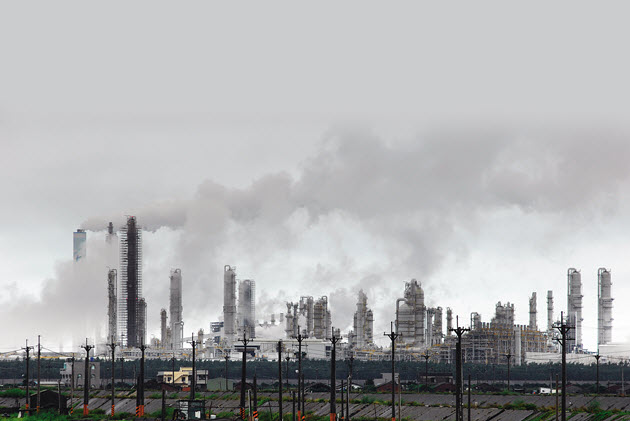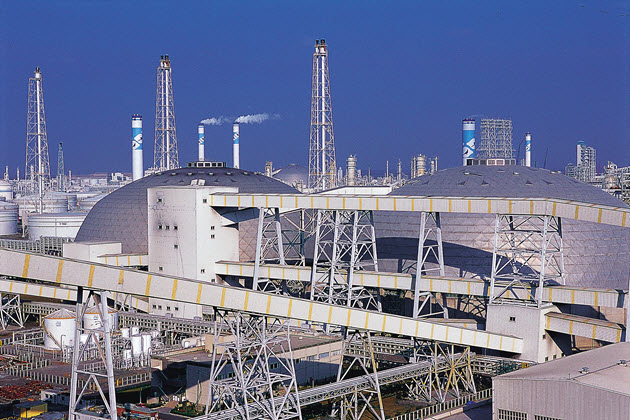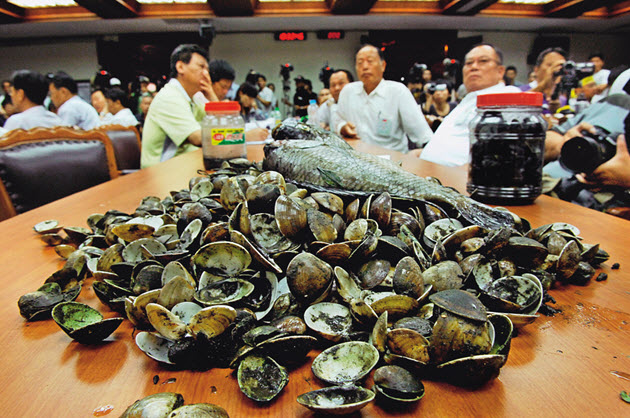Can Taiwan Live with Petrochemicals?

Source:Ming-Tang Huang
A massive conflagration has enraged the residents of Mailiao and revealed the combined high risk and low regulation of Taiwan's petrochemical sector. What can be done with this industry, which is both dangerous and essential?
Views
Can Taiwan Live with Petrochemicals?
By Ching-Hsuan HuangFrom CommonWealth Magazine (vol. 453 )
It is the height of summer in July in Yunlin County's Mailiao – the location of Taiwan's Sixth Naphtha Cracker facilities – and it is pouring rain, buffeted with gusts of cold wind powerful enough to send shivers up one's spine.
A spooky atmosphere envelops Mailiao. On the coast, where the sky meets the sea, the usual blue is displaced by a thick, impenetrable gray. Amidst the driving rain several dozen smoke stacks belch smoke, increasing the murkiness weighing heavily over the land.

Three days before, a large fire broke out at the hydrogen desulfurization (HDS) facility of the number two oil refinery plant of the Sixth Naphtha Cracker. The flames reaching straight into the sky were visible from as far away as Kukeng along the foothills. The next day, the oil was exhausted, but the hydrogen continued to burn.
Now it is the third day since the start of the blaze, and Democratic Progressive Party (DPP) chairwoman Tsai Ing-wen has journeyed south to Hou An, the village closest to the Sixth Naphtha Cracker facility. No amount of rain can stop local farmers from rushing to her, sacks of clams and soft-shelled turtles in hand, to tell her of their losses, during her brief visit of less than half an hour.
"It got this bad overnight, and they're still dying," an aquaculture farmer exclaims as he wipes drops of rain from his face. With his other hand he holds a sack of clams, the open shells indicating their dead state.
The fire that turned the dark night as bright as day burned away over 10 billion Taiwanese dollars of Formosa Plastics revenue, charring the company's reputation while threatening the future of the petrochemical and related industries, which account for 30 percent of Taiwan's manufacturing industry production value.
Jay Fang, Green Consumers' Foundation chairman, acridly observes: "This is a ‘celebratory' bonfire, for burning down Kuokuang Petrochemical."
Little Taiwan, Ethylene Giant
The Kuokuang Petrochemical Technology Company was the subject of a decade of controversy, from its name (vacillating between the Eighth Naphtha Cracker and Kuokuang Petrochemical), to shareholder structure, and plant location. With 43 percent of its shares held by state-owned CPC Corporation and the remainder in the hands of various private stockholders, the fate of Kuokuang Petrochemical Technology Company still hangs in the balance.
At present Taiwan has four light crude cracking facilities, the Third, Fourth, Fifth and Sixth Naphtha Cracker plants, together producing 4.2 million tons of raw upstream ethylene material for the petrochemical industry. This production ranks eighth in the world, with 90 percent self-sufficiency. However, three-quarters of this capacity comes from the Formosa Plastics Sixth Naphtha Cracker facility, with CPC accounting for merely one quarter.
The Mailiao Industrial Harbor Zone is currently the world's largest single petrochemical industrial complex. From the first through fourth phases of development, the complex actually has three alkene plants among the more than 60 total, "so it is not just the Sixth Naphtha Cracker, but should be Sixth, Seventh and Eighth," says a government official in charge of petrochemical industries, indicating the weight Mailiao pulls in Taiwan's petrochemical industry. Following refurbishment, CPC's Third Naphtha Cracker should count as the country's ninth, and "today's Kuokuang should be the tenth," the official adds.
A Fifth of Taiwan's Carbon Footprint
Little Taiwan has nine light crude cracking facilities, all concentrated along the heavily populated West Coast in major agricultural and fishing counties and cities. Although the petrochemical industry is Taiwan's second largest, it is also one of its biggest consumers of energy. The existing petrochemical cracking complexes emit nearly 500,000 tons of carbon dioxide each year, or 18 percent of Taiwan's total emissions, and use nearly 400,000 tons of water daily. In fact, the Mailiao Sixth Naphtha Cracker alone consumes more water than the 240,000 tons used by Yunlin County's entire population.
From such top authorities as Academia Sinica fellows to the medical community and environmental protection advocacy groups, a chorus of voices has joined to demand an end to the Kuokuang Petrochemical construction project. Citing economic development needs, however, the government has pressed on with this major construction project costing over NT$900 billion.

The two forces have butted heads in a stalemate, but the government has failed to clearly explain whether Taiwan's environment could tolerate so much ethylene. Meanwhile, opponents have also failed to take into consideration whether the public would be willing to bear the higher cost of clothing, building materials, water bottles and automobiles due to the higher cost of ethylene that would arise without the Kuokuang Petrochemical project.
The first, second and third cracking facilities have been retired into obsolescence, and the fifth cracker is slated for formal retirement in 2015. Yet with the additional projected capacity of the Phase Two Kuokuang Petrochemical project, Taiwan's total ethylene output will reach 6.47 million tons, a 50 percent increase. Under the present economic structure, increased ethylene production capacity is one of the main sources for economic growth in the government's eyes.
Dr. Tsai-Yi Wu, president of the Taiwan Research Institute (TRI), estimates that to reach an annual economic growth rate of 2.7 percent, the ethylene demand would be 5.21 million tons per year, and to reach 3.5 percent it would be 6.59 million tons. Moreover, only with the construction of the Kuokuang complex can Taiwan's over 90-percent self-sufficiency be maintained.
However, the issue is that 70 percent of midstream plastics products made from Taiwan's petrochemical industry are exported. For instance, Taiwan is the world's second largest artificial fiber producer. In the majority of cases, Taiwan receives the orders, and production takes place in China using upstream raw materials like PTA and EG, each of which Taiwan exports to China at a volume of around three million tons per year.
Just this past June Formosa Plastics subsidiary Formosa Chemicals announced its planned expansion at the Ningbo Petrochemical Zone in China, intended for the production of PTA and other items not on the "early harvest" list in the cross-strait Economic Cooperation Framework Agreement (ECFA). PX, a higher upstream raw material, will continue to be sent by ship across the strait from Mailiao, which currently sends over 50 percent of its production overseas.
Thus, the question arises: Is the self-sufficiency rate maintained under current policy really that of Taiwan, or is it the self-sufficiency rate of Taiwan-based corporations with offshore operations?
What Would Taiwan Stand On without the Petrochemical Pillar?
"A lot of people are for no overseas sales, just taking care of domestic demand. But then how was Taiwan's economic miracle achieved? Only exports generate big money," notes Hsieh Jun-hsiung, executive manager of the Petrochemical Industry Association, adding rhetorically: "Fine, don't do that business, but what piece of pie is the country going to eat then?"
The petrochemical industry is a pillar and a fundamental industry tied into a broad range of other industries, not only taking up one-third of manufacturing, but absolutely indispensable to the other two-thirds of industry affecting all aspects of modern living, from optoelectronics to electronics, pharmaceuticals, transportation and construction materials.
Taiwan in its present state cannot do without the petrochemical industry, which accounts for around 25 percent of GDP.
"Petrochemicals are too large of a pillar. If you took away the raw materials related to petrochemicals, a lot of industries would be unable to keep standing," Shih Yen-shiang, Taiwan's Minister of Economic Affairs, states frankly.
As neighboring countries like Singapore, South Korea and China continue to develop their respective petrochemical industries, Taiwan cannot afford to give up its own. In fact, even optoelectronics for the solar industry, one of Taiwan's six priority emerging industries, relies heavily on chemical products. In addition, "adjusting the industrial structure is a long-term goal; it could take 20 or 30 years to achieve," adds Minister Shih.
Clearly, the crux of the issue is not whether Taiwan can live with a petrochemical industry, but rather how Taiwan should live with it.
Major petrochemical countries like Japan and Singapore have located their light crude cracking complexes on sparsely populated offshore islands to minimize the impact on the environment and public safety. Similarly, Taiwan's Sixth Naphtha Cracker and Kuokuang Petrochemical complex are situated on plots of land separated from the original coastline by water channels 500 and 800 meters wide, respectively. Yet this is not enough on its own.
"We should stop and take stock, and pursue this industry with moderate development, and strict regulation," says Shih Yen-shiang. At this time the most viable option is replacement of obsolescent petrochemical facilities, using the latest equipment and technologies to reduce pollution and carbon dioxide emissions to a minimum.
The Kuokuang Petrochemical complex was originally slated to go into operation by 2015, just in time to replace the Fifth Naphtha Cracker, located in Kaohsiung, which is schedule for decommissioning. According to Kuokuang Petrochemical chairman Chen Bao-lang, the new complex will use the latest BACT (Best Available Control Technology) for greater efficiency. Following completion it will derive 60 percent of its energy from natural gas (Formosa Plastics' Sixth Naphtha Cracker still uses coal), slashing carbon dioxide emissions in half, from 24 million to 12 million tons.
Minister Shih admits that once the Kuokuang Petrochemical and Sixth Naphtha Cracker Phase Five expansion have been completed, beyond the improved productive efficiency and reduced pollution from the facility update program, "Taiwan's total petrochemical output will have reached its ceiling, leaving no further room for additional capacity."
Is It Possible to Live with Petrochemicals?
However, for a Taiwanese public increasingly concerned with its living environment and quality of life, promises that no more petrochemical facilities will be built in the future will not put an end to the conflict and controversy. The reason is that people are more interested in ensuring that the pipelines and oil drums all around them right now will not emit toxins that threaten their quality of life.
Management standards and capacities are keys to whether or not the petrochemical industry will have a future in Taiwan. The string of major work safety incidents at the Sixth Naphtha Cracker operated by Formosa Plastics, once viewed as an international benchmark of industry, betrays feeble management.
At a public hearing on "the desirability of proceeding with the phase five expansion of the Sixth Naphtha Cracker and Kuokuang Petrochemical project" held at the end of July, Chen Chuh-Yung, distinguished guest professor at National Cheng Kung University, angrily claimed that the Sixth Naphtha Cracker fire was in fact caused by a hydrogen explosion. He contends that Formosa Plastics is overly concerned with cost, and actually prides itself in its ability to squeeze out additional production capacity.
Chen believes that Formosa Plastics customarily pursues production capacity higher than provided by design specifications. If a pressure vessel is designed to accommodate only one kilo, the company will fill it beyond a kilo, he alleges. In chemical engineering, expanded production capacity amounts to increased pressure, raised temperature, and an accelerated reaction rate, which increase the burden on equipment. In oil refineries and petrochemical plants, which involve high pressure and continuous operation, whenever these factors increase, the dangers increase as well.
Moreover, improvement of all production processes and facilities must be based on thorough and strict research and development. "But unfortunately, the Sixth Naphtha Cracker is the world's largest single petrochemical complex, yet it lacks any semblance of an R&D center," he notes.
Even the government admits that "management standards" have been relaxed in recent years.
High Risk, Scant Oversight
The tightly monitored Sixth Naphtha Cracker complex is separated from the shore by a 500-meter channel. Situated beyond woods that were planted along the coast to buffer strong northeasterly winds, the offshore land reclamation area is the site of a veritable Formosa Plastics empire.

Minister Shih Yen-shiang, who holds a Ph.D. in chemistry from the Massachusetts Institute of Technology (MIT), admits that the government's thinking over the past decade or more has led to relaxed controls, to the extent that even standards for establishing manufacturing and processing plants across all industries have been scrapped. The government does not even have a single management center within an industrial complex as massive as the Sixth Naphtha Cracker area, so that in the wake of this industrial accident the Ministry of Economic Affairs (MOEA) lacks all authority to make demands or exercise management beyond labor inspections and environmental matters. "We cannot demand to come in unless they open the door and invite us," he laments.
In other words, this hints that Taiwan's high-risk industries count on "corporate discipline and self-monitoring," and lack outside oversight.
The MOEA is currently looking into legal regulations, having made the preliminary decision to regain a presence in the Mailiao Industrial Zone, establish a service center, and set related standards.
Relaxed management standards are what cause people to be increasingly worried about petrochemical facilities moving into their back yards. Meanwhile, an even more vexing issue is, what has kept Taiwan's petrochemical industry from upgrading?
If Taiwanese businesses can get beyond low-cost, general-purpose plastics for which quality is not the chief consideration, they can move toward development of precision, specialized chemical products with high added value. Examples include filters used in kidney dialysis machines costing tens of thousands of Taiwanese dollars per unit, or highly heat-resistant, high strength plastics for use as fasteners to replace metal screws and rivets in automobiles for lighter weight cars. Chen Chuh-Yung believes that if efforts toward these aims can succeed, "it will naturally lessen reliance on upstream petrochemical raw materials."
Professor Chen further asks, "If China Steel can lead midstream and downstream manufacturers to form an industry alliance to collaborate on developing high added-value products, why can't the petrochemical industry?"
Until the government and corporations can answer such questions, the skepticism and distrust burning in the minds of the Taiwanese people toward the petrochemical industry will not be extinguished.
Translated by the Chinese by David Toman






